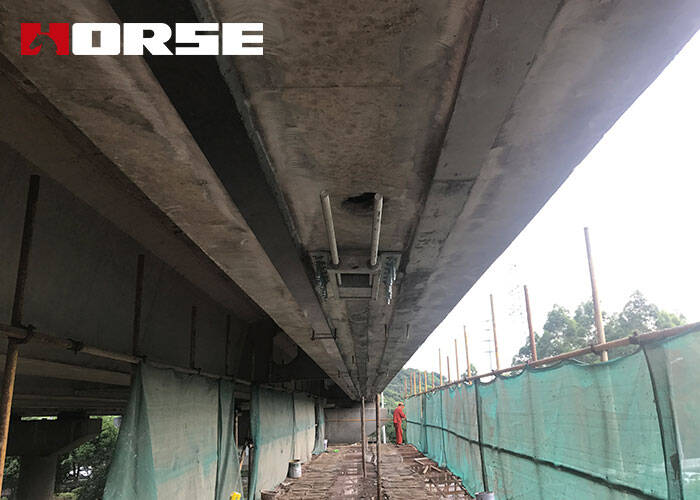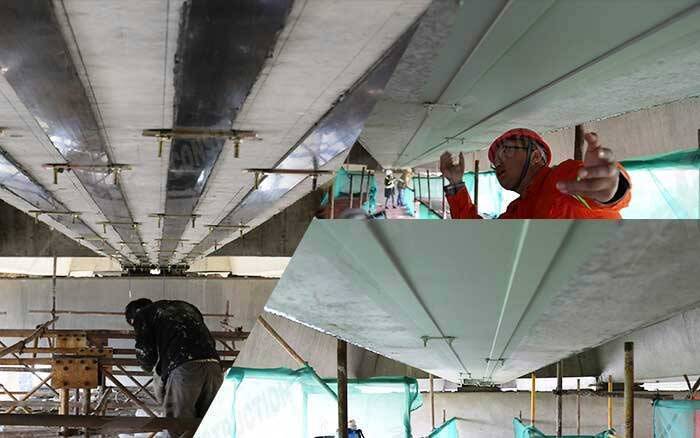Solutions
Horse Construction offers full range of structural strengthening materials with technical supports, documentation supports, products supports, project supports.
Application of Bridge Prestressed Strengthening Technology

The working principle of prestressed reinforcement technology
The bridge pre-stress reinforcement technology is different from the generalized bridge pre-stress technology. It is not a full pre-stress, but a part of the pre-stress is added to it, which is part of the pre-stress. Because the concrete volume of the bridge structure itself is large, the weight is also heavy. Under normal circumstances, a load will be applied, and the post-reinforcement material only bears the active load of the vehicle passing, so the effect of the post-reinforcement material will be delayed, and the effect is not very large in some limit states. The purpose of its work is to prevent the bridge structure from continuing to crack, or to keep the existing cracks unchanged or to make the cracks smaller, so as to keep the entire bridge structure stable, but also to prevent the bridge from developing new cracks. The stress state of the bridge is determined by three factors, namely the bending moment generated by the acting load, the geometric characteristics of the material section, and the rigidity, strength and flexibility of the main girder material. Among them, the load force includes permanent load and variable load, which come from the weight of the bridge, the load of mobile vehicles and the load of the crowd. The geometric characteristics include the moment of inertia, the cross-sectional area, the center position of the interface, and the geometric flexural modulus of elasticity. In bridge engineering, strengthening the bridge can increase the stiffness of the bridge, increase the use capacity of the bridge, and increase the durability of the bridge. Bridge prestressed reinforcement structure system:
(1) External prestressed reinforcement system.
(2) High-strength prestressed composite fiber reinforcement system.
(3) There is a bonding prestressed reinforcement system.
Materials used for external prestress reinforcement
In the external prestressed reinforcement technology, the construction is more convenient, the bridge cracks are also more obvious, and the instrument is easy to detect. Carbon fiber is a very good material with light weight and low cost. Therefore, the prestressed carbon fiber board reinforcement technology is a very good technology and a very promising technology. Recently, everyone uses this technology, and there is a growing trend. Compared with traditional bridge prestressed reinforcement technology, carbon fiber board has the following advantages:
(1) The strength of carbon fiber board far exceeds that of steel, and its own weight is much smaller.
(2) The corrosion resistance far exceeds the performance of steel.
(3) It is very easy to form bonded prestressed reinforcement.
(4) The fatigue performance and low relaxation performance of the prestressed carbon fiber sheet are excellent.
For the above reasons, it is feasible to use carbon fiber board for bridge reinforcement in external prestressed reinforcement, and it is very likely to be the future development direction. Therefore, many pre-stressed bridges are reinforced with carbon fiber board. According to data, about 20 bridges in the prestressed reinforcement of domestic bridges are made of carbon fiber, and this technology is used more and more in bridges.

Prestressed reinforcement method for externally anchored FRP strip
Fiber reinforced composite material is abbreviated as FRP. FRP composite material is a high-performance material formed by mixing fiber material and matrix material (resin) in a certain proportion. This material is not energized, it is safe to use, less recyclable, and not afraid of fatigue. In terms of machinery, it is very strong, hard and light. FRP has always been carried out in the laboratory. After so many years of development, there is still not much progress, because it is impossible to find FRP anchors and fixtures suitable for on-site. But this is the key technology for bridge prestressed reinforcement, and the use of corrugated tooth anchors solves the anchoring problem of this sheet. This method uses clamping at both ends and then fixing in the middle, so that the FRP material has to be stretched and the bridge is prestressed. This method does not require special tensioning equipment, greatly improves the concrete effect of reinforcement, and the operation is very simple.
Simply stick FRP on the surface of the bridge structure and reinforce it. However, when the component fails, the prestress of the sheet in the FRP is still relatively small, the material cannot fully exert its performance, and the strength cannot be expressed. In actual bridge engineering, there will be a little initial stress on the reinforced bridge components. If the general FRP sheet reinforcement method is still used, its stress will become much slower in the secondary force, and the reinforcement effect will not be significant. . In order to make full use of the high-strength properties of FRP and achieve good results, this reinforcement technology is very important and valuable. By prestressing the FRP sheet, the development speed of the crack can be greatly delayed, which is beneficial to alleviate the width of the crack, and to a certain extent, it can also reduce the opening of the crack. Reducing the deflection of the bridge structure and reducing the stress and strain of the steel bars inside the bridge can improve the load-bearing capacity of the bridge, increase its performance, and make its service life longer.
Summarize
Reinforcement of bridge prestressed reinforcement can effectively eliminate problems such as cracks, uneven sinking, and temperature changes in the widening and strengthening of old bridges. In the hypothesis of the new bridge, because the pre-stressed reinforcement of the bridge itself has the characteristics of low cost, convenience, and material saving, it can promote the emergence of a batch of new bridge structures. In the selection of specific construction methods or construction techniques, the actual economic benefits should be considered.
You can find anything here you are in need of, have a trust trying on these products, you will find the big difference after that.